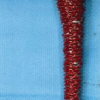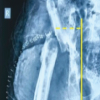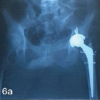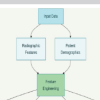Even with significant progress of ceramic components, failure of fourth-generation heads can arise years after index arthroplasty.
Ashlie Boner B.S. Department of Orthopaedics and Joint Replacement Unit, Mercy Medical Center, Baltimore, Maryland. E-mail: aboner@mdmercy.com
Introduction: Atraumatic ceramic femoral head fracture is an uncommon but overwhelming complication of total hip arthroplasty (THA). The complication rate is low, with few reports in the literature. It is critical to continue researching late fracture risk to mitigate these instances.
Case Report: A 68-year-old Caucasian female presented with an atraumatic ceramic femoral head fracture in the setting of a ceramic-on-ceramic THA 17 years after primary surgery. The patient was successfully revised to a dual-mobility construct with a ceramic femoral head and a highly cross-linked polyethylene liner. The patient returned to normal function without pain.
Conclusion: The complication rate for fracture of the ceramic femoral head is as low as 0.001% for fourth-generation aluminum matrix composite designs, while the complication rate of late atraumatic ceramic fracture is largely unknown. We present this case to add to the current literature.
Keywords: Total hip arthroplasty, revision total hip arthroplasty, ceramic head fracture.
Ceramic femoral head fracture is an uncommon rare but catastrophic complication of total hip arthroplasty (THA). The rate of this complication is as low as 0.001% for fourth-generation aluminum matrix composite designs [1]. However, the incidence of late (defined here as 10 years or more) atraumatic ceramic fracture is largely unknown. There are only four other reported cases [1,2,3,4]. Here, we account for a patient’s case of late, atraumatic ceramic femoral head fracture in the setting of a ceramic-on-ceramic THA. The patient was successfully revised to a dual-mobility construct with a ceramic femoral head and a highly cross-linked polyethylene liner. The original femoral stem was maintained using a trunnion adapter. A relevant review of the literature was performed and revealed the need for more data and a deeper understanding of these late-presenting ceramic fractures. We present this case to add to the current small body of literature. Ceramic femoral head fracture is a well-established complication of THA. The majority of these fractures happen early, with 80% happening within 4 years and 90% within 6 years postoperatively [5]. Associations with fracture include trauma, component malposition (such as high abduction and anteversion angles), and hip dislocation. Smaller head sizes and shorter neck lengths seem to have a higher fracture risk. The association is believed to be the same for alumina and alumina composite heads [5,6].
A 68-year-old Caucasian female was seen in our clinic in March 2022 with sudden onset of right groin pain. Initially, in March of 2005, at an outside institution, she had her index right THA with a 48-mm acetabular cup, a 28-mm inner diameter ceramic linter, size 7 femoral stem, and a 28-mm ceramic head with a 0-mm neck length (Osteonics Alumina C-taper, Stryker Howmedica Osteonics, Rutherford, N.J., USA). The patient initially did well. She next presented to our clinic in 2013 with left hip pain and degenerative changes. We subsequently performed left THA. During follow-up in 2014, she began to complain about painless clicking of her right hip. We counseled the patient to follow up if the symptoms worsen, otherwise follow-up in 1 year. Films showed an acetabular cup that was in 18.8° of anteversion and 66° of abduction. The patient again followed up in 2020 with worsening of the painless clicking and subluxation sensation, and she was indicated for acetabular revision. However, the patient did not proceed with revision arthroplasty stating that her issue seemed to have been resolved. Then, in March of 2022, she was seen in our clinic with right groin pain and a crunching sensation. Films revealed that the ceramic femoral head had fractured, and she was again indicated for revision of her right THA. No other radiographic changes were noted (Fig. 1). The patient’s THA was revised through a Hardinge direct lateral approach. Metallosis of the tissues was noted, the ceramic femoral head was in four major fragments (Fig. 2). The patient was seen in May 2023, 1 year following revision surgery. The patient had no pain, limp, or disability and a perfect score on the Hip Disability and Osteoarthritis Outcome Score for Joint Replacement Questionnaire. The ceramic liner showed metal staining from stem abrasion and the trunnion had a small notch along the proximal rim that did not affect the body of the trunnion itself. The fragments were removed. The ceramic liner was removed, and the acetabular cup was removed. The stem was well fixed and in good position and was left in place. A dual-mobility head was placed together with a ceramic head and a titanium sleeve on the original trunnion (Stryker Biolox Dual Mobility Vit E 42 mm/28 mm/E; Stryker, Howmedica, Osteonics Inc., Rutherford, N.J., USA). The patient tolerated the procedure well. The patient had an uncomplicated recovery and returned to normal function without pain. The patient was seen 2 weeks, 6 weeks, and 1 year following revision. They reported no post-operative complications and were pleased with the outcome of their surgery.
Ceramics have been in use in hip replacement for many decades. Interest remains high due to ceramic inherent wettability and very low wear rates. However, the Achilles heel of this material has always been the fracture risk. First-generation ceramics suffered from large grain structure, impurities, and inadequate manufacturing techniques. Fracture rates as high as 13.4% were reported [7]. Third-generation pure alumina ceramics, such as Biolox Forte, reduced the grain size of the material and improved manufacturing techniques. Fourth-generation ceramics, such as Biolox Delta, or alumina matrix composite, added zirconia and trace metals to strengthen the material. Lee and Kim [5] reported on the incidence of fracture of third- and fourth-generation ceramics from the manufacturer’s database. The fracture rate was 0.02% and 0.001%, respectively. They did report a trend for an increased fracture rate with smaller head (28 mm) sizes. These rates underestimate the true rate of fracture because they only include the fractures reported to the manufacturer. Reporting from the NJR dataset, Howard et al. stated fracture rates of 0.119% for third-generation heads and 0.009% for fourth-generation heads. The author did note an elevated incidence of revision due to fracture with increasing body mass index (BMI) but did not note an increase in head fracture rate with ceramic-on-ceramic articulations versus ceramic on polyethylene [2]. There are very few reported cases of late, atraumatic fracture of a ceramic femoral head. Papaioannou et al. [1] reported on a 71-year-old female who was 11 years out from her index surgery. The implants were a third-generation 28-mm ceramic femoral head (alumina, Biolox Forte, CeramTec, Plochingen, Germany) with a fourth-generation ceramic liner (Biolox Delta, CeramTec, Plochingen, Germany). Her risk factors were stated to be increased activity level, obesity, 28-mm ceramic head, and alumina on alumina matrix composite articulation, which is thought to cause low-temperature degradation of the zirconium [1]. To date, the delayed onset of ceramic head fracture is reported at 16 years by Kocadal et al. Their patient, a 52-year-old female, presented with right groin pain. The components were a ceramic liner and a 28-mm alumina ceramic femoral head. They state that the patient’s only risk factor for revision was the 28-mm femoral head as the patient’s BMI was 28.2 kg/m2 and her components were not malpositioned [3]. Tucker and Acharya report an unusual case of a fractured ceramic head with an ultra-high-molecular-weight polyethylene (UHMWPE) liner. The patient, a 68-year-old male, was initially revised to a 28-mm zirconium oxide femoral head with 7-mm neck length on an UHMWPE liner due to wear of the previous metal on UHMWPE bearing surface. The patient presented 14 years later with a fractured head, right hip pain, and grinding. The authors did not document a risk factor for the fracture [4]. Finally, Nho et al. described a 72-year-old woman with left hip pain and clunking who was 12 years from her index surgery. Her initial implants were a 28-mm, short neck, zirconium oxide ceramic head on a UHMWPE. The patient’s initial components were found to be in acceptable abduction and anteversion. No risk factors were identified [8].
In our case, the patient had an elevated acetabular abduction angle of 66° and a clinical history of subluxation. She also had a 28-mm head with a short neck. Both are common risk factors for fracture. She was indicated for revision 2 years prior to her eventual femoral head fracture.
Previous studies have recommended revision of fractured ceramic implants to new ceramic-on-ceramic articulations because of the residence of microscopic ceramic particles and accelerated wear with non-ceramic bearings [9]. However, the accelerated wear has not been reported with the use of dual-mobility bearings as used in this case. There has been one other report of a revision of a fractured head to a dual-mobility bearing [10]. It remains to be seen if this construct will be durable. Unfortunately, the risk of late fracture of the ceramic head in patients who experience subluxation is unknown.
References
- 1.Papaioannou I, Repantis T, Pantazidou G, Baikousis A, Korovessis P. Late onset atraumatic ceramic head fracture of a hybrid ceramic bearings total hip arthroplasty. Cureus 2021;13:e13726. [Google Scholar]
- 2.Howard DP, Wall PD, Fernandez MA, Parsons H, Howard PW. Ceramic-on-ceramic bearing fractures in total hip arthroplasty: An analysis of data from the National Joint Registry. Bone Joint J 2017;99-B:1012-9. [Google Scholar]
- 3.Kocadal O, Ozler T, Bolukbasi AE, Altintas F. Non-traumatic Ceramic Head Fracture in total hip arthroplasty with ceramic-on-ceramic articulation at postoperative 16th years. Hip Pelvis 2019;31:124-7. [Google Scholar]
- 4.Tucker D, Acharya M. Unusual prosthetic femoral head fracture in total hip arthroplasty: Ceramic on polyethylene articulation. BMJ Case Rep 2014;2014:bcr2013202685. [Google Scholar]
- 5.Lee GC, Kim RH. Incidence of modern alumina ceramic and alumina matrix composite femoral head failures in nearly 6 million hip implants. J Arthroplasty 2017;32:546-51. [Google Scholar]
- 6.Traina F, De Fine M, Di Martino A, Faldini C. Fracture of ceramic bearing surfaces following total hip replacement: A systematic review. Biomed Res Int 2013;2013:157247. [Google Scholar]
- 7.Knahr K, Böhler M, Frank P, Plenk H, Salzer M. Survival analysis of an uncemented ceramic acetabular component in total hip replacement. Arch Orthop Trauma Surg (1978) 1987;106:297-300. [Google Scholar]
- 8.Nho JH, Park JS, Song US, Kim WJ, Suh YS. Ceramic head fracture in ceramic-on-polyethylene total hip arthroplasty. Yonsei Med J 2013;54:1550-3. [Google Scholar]
- 9.Traina F, Tassinari E, De Fine M, Bordini B, Toni A. Revision of ceramic hip replacements for fracture of a ceramic component: AAOS exhibit selection. J Bone Joint Surg Am 2011;93:e147. [Google Scholar]
- 10.Patetta MJ, Kayupov E, Karam JA, Chmell SJ. Fourth-generation ceramic head fracture in dual mobility total hip arthroplasty: A case report. J Orthop Case Rep 2022;12:98-101. [Google Scholar]









